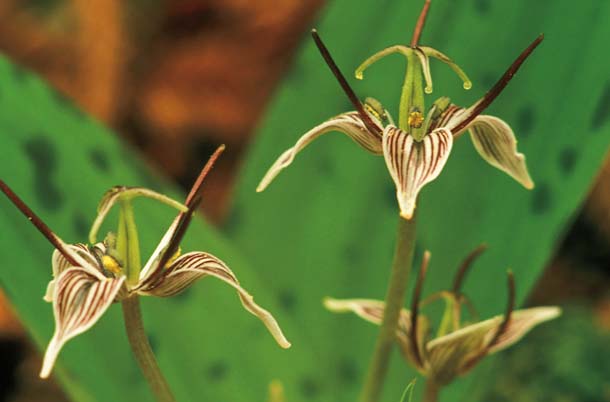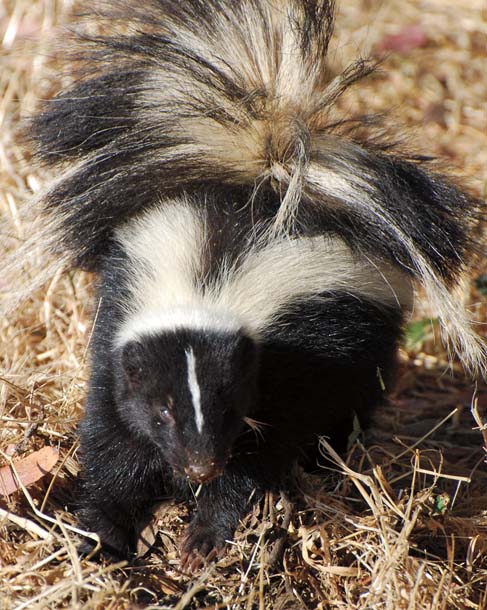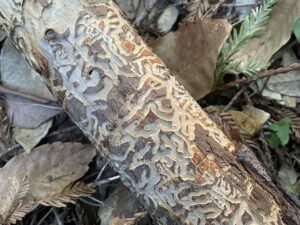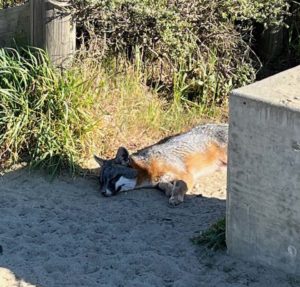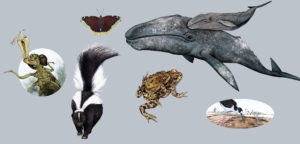“Pee-yew” is not something we say often about a flower’s odor, but getting “nose-to-bloom” with a slinkpod (Scoliopus bigelovii) in a botanic garden or coast redwood forest may make you say it! Its other name is fetid adder’s tongue, but you can call them “stinkpods.”
Small flies, called fungus gnats, are attracted to this lily by its odor of “meat gone bad.” They are pollinators; their visits result in seedpods that grow into the duff of the forest floor, appearing to “slink” into the ground.
Slinkpod flowers use a bad smell for a good purpose. Some animals are well-known for putting their own stink to good use, too.
The best known “bad actor” has to be the striped skunk (Mephitis mephitis). It looks like a piece of a zebra, black with two white stripes on its back that meet to form a V at its head. The skunk’s bold colors are a warning to keep away. When this doesn’t work, the striped skunk will stamp its feet and even run a few steps toward and then away from its foe. The related (though smaller) spotted skunk will do a front handstand like a gymnast, bringing its tail over its back for better aim, if necessary.
Years ago, a young student asked me about the skunk’s spray: “Is it quick like lightning, or does it float like smoke?” The answer is “yes and yes.” When chased by a predator it can’t see, the skunk releases a very fine mist behind it, which a pursuer must turn away from to avoid. But if the skunk can see its tormentor, it directs a stream at the enemy’s face.
The odor comes from anal scent glands, which all carnivores have (but skunks have them big time). Skunks put very tiny amounts of scent into their poop to let other skunks know they are around. Our noses can detect 10 parts of skunk scent in a billion parts of air, so its odor may reach you from miles away.
One predator not bothered by the odor is the great horned owl, because it has a poor sense of smell. Owls are just about the only predators that capture and eat skunks regularly.
Another stinky creature that does headstands is the darkling beetle, Eleodes dentipes (or its other local cousin, Coelocnemis californicus). These all-black beetles are active mostly at dusk and dawn, but can be seen in the daytime, very conspicuous against a grass or soil background. When disturbed, the darkling beetle puts its head down and backside up as a warning sign that it packs a punch in its posterior. Glands there can spray or dribble drops of bad-smelling and staining chemicals called quinones. These are similar to stuff in “quick tanning” lotions, so you can get a fake tan on your fingers from handling darkling beetles.
These large beetles are not always protected by their gymnastic behavior. Striped skunks will roll darkling beetles around till they use up their spray, and then eat them. What goes around comes around!
Get Out
Nature is full of smelly stuff, some of it hidden and some of it right under our noses. It might be hard to see a skunk–they’re shy animals that sleep by day and forage for food from dusk till dawn–but if you’re “lucky,” you may smell the lingering result of a skunk’s confrontation with another animal. Darkling beetles are easier to find than skunks if you look for them at the S.F. Zoo’s Insect Zoo or at CuriOdyssey at San Mateo’s Coyote Point Recreation Area.
Slinkpod flowers show up (and smell up) in January and February. Look for them in moist, shady places like Muir Woods and Pacifica’s San Pedro County Park. Many other native plants in parks and botanic gardens have smelly parts. At the Regional Parks Botanic Garden in Tilden Regional Park, the UC Berkeley Botanical Garden, and the San Francisco Botanical Garden, you can have a skunklike experience with skunk cabbage flowers in April or May. Like their namesakes (skunks and cooked cabbage), they are seriously stinky. Other garden plants, like sage and spicebush, have leaves that smell nice to us but nasty to animals that might otherwise eat them. Sample leaf scents by rubbing them between your fingers–no need to pick them. [Sue Rosenthal]

